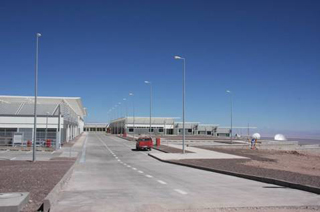
Masato Ishiguro
Professor emeritus at NAOJ
Former ALMA-J Project Director
Former JAO international staff
(at the time of writing)
|
June 2008
・ALMA Construction Site -1-
July 2008
・Scenery around the ALMA Office
August 2008
・ALMA Construction Site -2-
September 2008
・Trees and Flowers in Santiago -1-
October 2008
・Trees and Flowers in Santiago -2-
November 2008
・Clouds Seen in the Atacama Desert
December 2008
・The Dog that Trots about Finds…
January 2009
・ALMA Construction Site -3-
February 2009
・Memories of the Atacama Desert
March 2009
・Chile from North to South
ALMA TOP page
|
- ALMA Construction Site -Part 1-
-
From November 2007, I started to work as an ALMA international staff at the Joint ALMA Office in Chile. In this column titled "Atacama Report - Wind from the Andes," I will write about my work at the ALMA construction sites and my daily life in Santiago.
As an ALMA international staff, I belong to AIV (Assembly, Integration and Verification) team, which is responsible for assembling and testing the ALMA components developed and fabricated in various parts of the world and integrating them into one ALMA telescope. The number of the AIV team members is currently 30, including those from the two Technical, Computing, Science, and Administration Teams, working on site by rotation for a variety of tasks. Two thirds of the AIV team members are Chileans, and remaining are those from the U.S., Canada, Sweden and one from Japan. I have been assigned to the leader of the Science Team and worked with members from different countries. It is the first time I work as a member of an international team, but I have been very impressed by the unity of the team that is getting stronger day by day. I think this may be because all the members of my team are cheerful persons who can think positive.
The standard work shift is "8-6 shifts," which means that we work on site for 8 days during a two-week period and take 6 days off to take a rest at home. In this shift, we have to work for 8 consecutive days at the OSF (Operations Support Facility) at 3000 meters or at the AOS (Array Operations Site) at 5000 meters, but after such highly concentrated work, we can take a consecutive 6 days off. At the beginning, I also worked in this 8-6 shifts, but after a while I changed it to 5-2 shifts during one-week period so that I can have contact with other teams' members during my stay at the OSF. In this 5-2 shifts, I am traveling between Santiago and Calama by airplane every week: Every Monday morning, I wake up around 4 o'clock and goes to Santiago airport by taxi. As there are no rush-hour traffic jams early in the morning, I can arrive at the airport within 20 minutes. The shortest travel time I ever achieved from my home to the departure gate is 30 minutes. After a 2-hour flight from Santiago to Calama and a 90 minute-drive from Calama airport to the OSF, I can arrive at the OSF before 11 o'clock in the morning. On Thursday, I leave the OSF around 3 o'clock in the afternoon, and go back to Santiago at night. On Friday, I work at the JAO (Joint ALMA Office) in Santiago all day. This is my normal weekly routine.
I will show you some pictures taken at the OSF recently. Photo 1 shows the OSF-TF (Technical Facility) that will soon be completed. TF is a big building that will be the center of ALMA operations with a remote control room for the telescope constructed at the AOS, a maintenance room for antennas and receiver components, rooms for staff, and a warehouse. Now I am working surrounded by equipment in a small temporary laboratory, but I will also have a room in this building soon.
 |
| Photo 1: ALMA OSF Technical Facility under construction at 3000 m a.s.l. (the white object in the back right is a Japanese 12-m antenna). |
Photo 2 shows four Japanese 12-m antennas and a North American 12-m antenna. You can see close-up photos of Japanese antennas at the Japanese ALMA website http://www.nro.nao.ac.jp/alma/J/. Other North American antennas are being assembled in a hangar, while it will take some time before the European team starts the antenna tests. A building shown at right in the photo is a bunkhouse (lodge for workers) with 72 rooms that was newly constructed for an increasing number of staff. Before this bunkhouse was constructed, we had to stay at different places every week and sometimes share a room, but now I can use a single room for myself during a stay, which made my weekly stay at the OSF much more comfortable.
 |
| Photo 2: Japanese and North American antennas during evaluation test, and lodging facility (right). |
|

